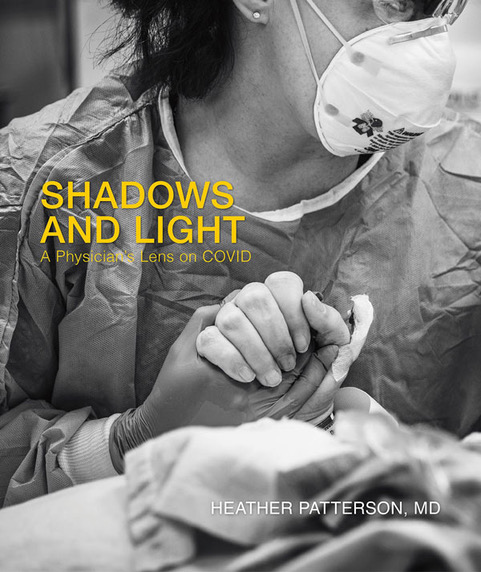An emergency physician as well as a photographer, Heather Patterson worked with Alberta Health Services to create this visually striking and compelling narrative of the first two years of the COVID-19 pandemic as it swept through Alberta hospitals. Capturing the intense medical situation in black-and-white photos, along with vignettes and reflections on the onslaught of the virus, Patterson has created a coffee table book with intellectual and emotional heft.
The book is arranged in sections, corresponding to the “waves” of the pandemic, as cases rose and fell and rose again. For medical staff, each wave had its own characteristics—from the challenge and novelty of the first wave, which brought fear of the unknown but also a chance to practise high-stakes, satisfying medicine; to the exhausting stresses of the second wave, when patients were fewer but sicker; to the frustrations and burnout of subsequent waves coming after vaccines were widely available but health staff had to now confront not only a disease but also the aggressive politicization of public health. Without comment, Patterson shows the toll that anti-vaccine protests at hospitals took on healthcare workers who had to wade through vitriol every day, mere months after they had been hailed as heroes. She ends on a bleak note, observing that while she is not planning to leave medicine, she understands why many of her colleagues are heading for the exit.
Inside the hospital, Patterson shows different patients’ journeys with the virus. There’s the long, tedious wait for beds to become available; the sped-up staccato of a code or an emergency intubation; the boredom of spending hours in bed, too sick to move and with no visits from friends or family, interrupted only by “proning” (turning patients from lying on their backs to their fronts to help them breathe better). Patterson shows patients who become stable enough to leave the hospital to recover at home, and others who come to the end of their lives. She is an empathetic recorder, not a voyeur, and her camera remains focused on the moments of human connection, even when the final separation is impending.
Taking a broad view of what constitutes “health work,” Patterson also photographs laboratory technicians, kitchen workers and cleaning staff, remarking that even though she has worked in these hospitals for years, it wasn’t until COVID hit that she learned the names and life stories of people working in concert with her, often in physical proximity.
Both she and her husband are physicians, and they had to strategize to avoid bringing the virus home to their children. One shower in their house was assigned as “decontamination,” and Patterson recounts how she and her husband would strip off all their clothes when they got home from work and race naked through the living room to shower before interacting with any other family members. More sombrely, she also tells how she and her husband gave each other their computer passwords and updated their wills and end-of-life documents.
COVID is difficult to represent in images—the virus is too small to be seen and people sick with COVID look like most other sick people. This effect is heightened by the PPE gear that healthcare workers and patients alike must wear, so that at first glance the COVID-stricken hospital wards look like monotonous scenes of people in long gowns, caps and masks manoeuvring around beeping and clicking machines. When we catch sight of patients who are not gowned and capped, the sight of human bodies in their unadorned state is unnerving.
Within this visual landscape, Patterson focuses on the hands and eyes of staff and patients. These small but eloquent parts of the body convey fear, hope, happiness, exhaustion, sadness and grief. Her photography reveals the emotions roiling beneath the surface of healthcare work during a global catastrophe.
Amy Kaler is a professor of sociology at the University of Alberta and the author of Until Further Notice (UAP, 2022).
_______________________________________


